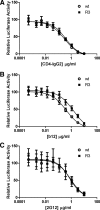Evolution rescues folding of human immunodeficiency virus-1 envelope glycoprotein GP120 lacking a conserved disulfide bond
- PMID: 18753405
- PMCID: PMC2575144
- DOI: 10.1091/mbc.e08-07-0670
Evolution rescues folding of human immunodeficiency virus-1 envelope glycoprotein GP120 lacking a conserved disulfide bond
Abstract
The majority of eukaryotic secretory and membrane proteins contain disulfide bonds, which are strongly conserved within protein families because of their crucial role in folding or function. The exact role of these disulfide bonds during folding is unclear. Using virus-driven evolution we generated a viral glycoprotein variant, which is functional despite the lack of an absolutely conserved disulfide bond that links two antiparallel beta-strands in a six-stranded beta-barrel. Molecular dynamics simulations revealed that improved hydrogen bonding and side chain packing led to stabilization of the beta-barrel fold, implying that beta-sheet preference codirects glycoprotein folding in vivo. Our results show that the interactions between two beta-strands that are important for the formation and/or integrity of the beta-barrel can be supported by either a disulfide bond or beta-sheet favoring residues.
Figures







Similar articles
-
Functional analysis of the disulfide-bonded loop/chain reversal region of human immunodeficiency virus type 1 gp41 reveals a critical role in gp120-gp41 association.J Virol. 2001 Jul;75(14):6635-44. doi: 10.1128/JVI.75.14.6635-6644.2001. J Virol. 2001. PMID: 11413331 Free PMC article.
-
Caprine arthritis-encephalitis virus envelope surface glycoprotein regions interacting with the transmembrane glycoprotein: structural and functional parallels with human immunodeficiency virus type 1 gp120.J Virol. 2003 Nov;77(21):11578-87. doi: 10.1128/jvi.77.21.11578-11587.2003. J Virol. 2003. PMID: 14557643 Free PMC article.
-
Only five of 10 strictly conserved disulfide bonds are essential for folding and eight for function of the HIV-1 envelope glycoprotein.Mol Biol Cell. 2008 Oct;19(10):4298-309. doi: 10.1091/mbc.e07-12-1282. Epub 2008 Jul 23. Mol Biol Cell. 2008. PMID: 18653472 Free PMC article.
-
Stabilizing exposure of conserved epitopes by structure guided insertion of disulfide bond in HIV-1 envelope glycoprotein.PLoS One. 2013 Oct 16;8(10):e76139. doi: 10.1371/journal.pone.0076139. eCollection 2013. PLoS One. 2013. PMID: 24146829 Free PMC article.
-
Redox control on the cell surface: implications for HIV-1 entry.Antioxid Redox Signal. 2003 Feb;5(1):133-8. doi: 10.1089/152308603321223621. Antioxid Redox Signal. 2003. PMID: 12626125 Review.
Cited by
-
Several N-Glycans on the HIV Envelope Glycoprotein gp120 Preferentially Locate Near Disulphide Bridges and Are Required for Efficient Infectivity and Virus Transmission.PLoS One. 2015 Jun 29;10(6):e0130621. doi: 10.1371/journal.pone.0130621. eCollection 2015. PLoS One. 2015. PMID: 26121645 Free PMC article.
-
Deletion of the highly conserved N-glycan at Asn260 of HIV-1 gp120 affects folding and lysosomal degradation of gp120, and results in loss of viral infectivity.PLoS One. 2014 Jun 26;9(6):e101181. doi: 10.1371/journal.pone.0101181. eCollection 2014. PLoS One. 2014. PMID: 24967714 Free PMC article.
-
Strategies for successful recombinant expression of disulfide bond-dependent proteins in Escherichia coli.Microb Cell Fact. 2009 May 14;8:26. doi: 10.1186/1475-2859-8-26. Microb Cell Fact. 2009. PMID: 19442264 Free PMC article.
-
Effect of Glycosylation on an Immunodominant Region in the V1V2 Variable Domain of the HIV-1 Envelope gp120 Protein.PLoS Comput Biol. 2016 Oct 7;12(10):e1005094. doi: 10.1371/journal.pcbi.1005094. eCollection 2016 Oct. PLoS Comput Biol. 2016. PMID: 27716795 Free PMC article.
-
Two HIV-1 variants resistant to small molecule CCR5 inhibitors differ in how they use CCR5 for entry.PLoS Pathog. 2009 Aug;5(8):e1000548. doi: 10.1371/journal.ppat.1000548. Epub 2009 Aug 14. PLoS Pathog. 2009. PMID: 19680536 Free PMC article.
References
-
- Berendsen H.J.C., Postma J.P.M., Van Gunsteren W. F., Di-Nola A., Haak J. R. Molecular dynamics with coupling to an external bath. J. Chem. Phys. 1984;81:3684–3690.
-
- Berendsen H J.C., Postma J.P.M., Van Gunsteren W. F., Hermans J. Interaction Models for Water in Relation to Protein Hydration. Dordrecht, The Netherlands: Reidel Publishing; 1981.
-
- Chen B., Vogan E. M., Gong H., Skehel J. J., Wiley D. C., Harrison S. C. Structure of an unliganded simian immunodeficiency virus gp120 core. Nature. 2005;433:834–841. - PubMed
-
- Chou P. Y., Fasman G. D. Conformational parameters for amino acids in helical, beta-sheet, and random coil regions calculated from proteins. Biochemistry. 1974;13:211–222. - PubMed
Publication types
MeSH terms
Substances
LinkOut - more resources
Full Text Sources

